Greenroofs.com Project of the Week: 9/26/11
Casa Feliz Studios
San Jose, CA, USA
5,375 sf. Greenroof
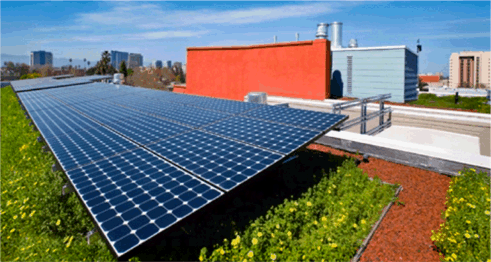
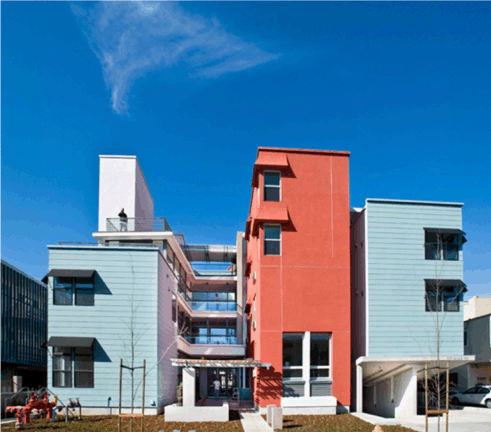 Year: 2009
Year: 2009
Owner: First Community Housing
Location: San Jose, CA, USA
Building Type: Multi-Family Residential
Type: Extensive
System: Custom
Size: 5,375 sq.ft.
Slope: 1%
Access: Inaccessible, Private
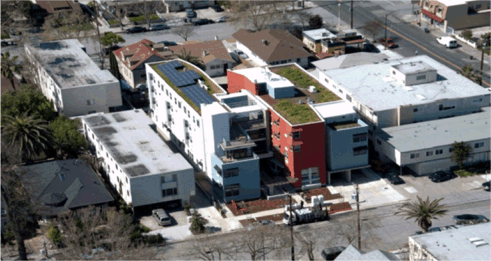
Project Description & Details
Casa Feliz is a multi-award winning affordable housing project that is LEED NC Gold certified. The brainchild of First Community Housing, a San Jose affordable housing developer known for its innovative green-building practices, it’s located on a tight 0.34-acre infill site near downtown San Jose. Casa Feliz Studios provides 60 units of high-quality affordable housing for extremely low-income tenants – 35% of the studios are set aside for tenants living with developmental disabilities.
There are five distinct living roof areas at Casa Feliz. The large two top floor living roofs, one of which is planted beneath a 16-kilowatt photovoltaic array, are planted with a mixture of annual and perennial grasses and wildflower species that do not require irrigation. The native plantings are designed to attract insects, birds and butterflies, including the Bay Checkerspot, an endangered butterfly native to the area. Tremco’s biodegradable modular greenroof system, BioTray™, provides immediate erosion control and thermal resistance. The integrated system of living roofs and at-grade bioswales retain up to 80% of stormwater on site.
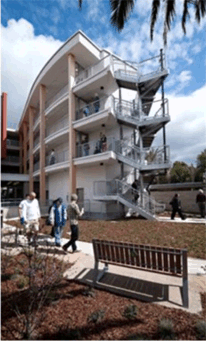
Designers/Manufacturers of Record
Architect: Rob Quigley Architects, FAIA
Contractor: Branagh, Inc.
Civil Engineer: Carroll Engineering
Living Roof Consultant: Rana Creek
Landscape Architect: Cottong & Taniguchi
Energy Consultant and Commissioning Agent: Guttmann & Blaevoet
Structural Engineer: Vertech
Living Roof Monitoring: Agilewaves
Waterproofing: Tremco Inc.
LEED Consultant: Simon & Associates
Modular Greenroof System: BioTray™ by Tremco Inc.
Additional Info
Completed in spring 2009, First Community Housing and Rob Quigly Architects designed Casa Feliz Studios to replace an aging residential hotel near downtown San Jose; the project serves extremely low income tenants (20 to 35% AMI) with 21 units for residents with developmental disabilities. On-site tenant support services are provided and facilitate communication between residents and property management and all residents receive a free annual Eco Pass for free bus and light rail travel within the County.
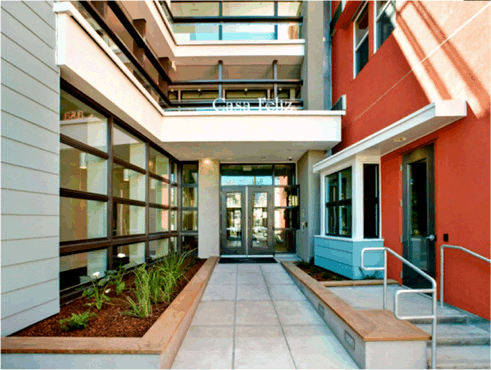
“Partnering with the city and the local community, First Community Housing sought to meet a dire need in the city by constructing maximum density SRO units in a central location, with amenities designed to help residents connect to the community.” ~ Home Depot Foundation 2008 Awards of Excellence Affordable Housing Built Responsibly Case Study
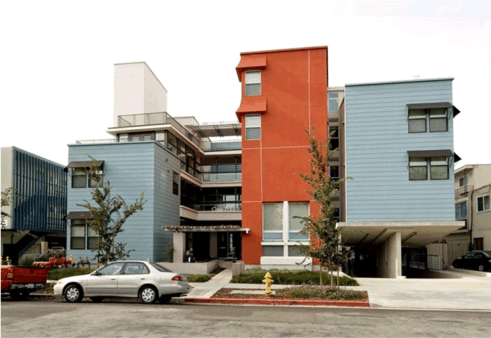
At less than a half acre, the infill site required a creative and efficient design. Four stories of housing are located over a single level of below-grade parking for 22 cars; the 59 units average 255 square feet.
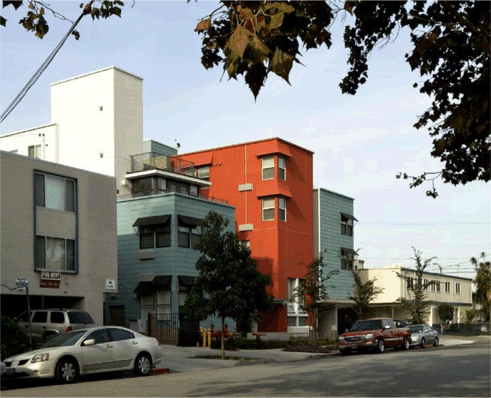
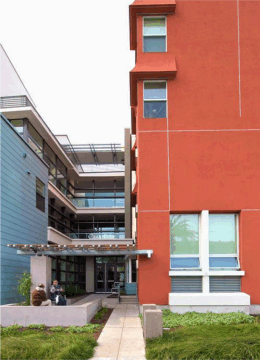 Because the residents of the community, living in a combination of deteriorating apartment buildings and Victorian-style houses, were worried about the potential appearance of the building, a series of community meetings were scheduled.
Because the residents of the community, living in a combination of deteriorating apartment buildings and Victorian-style houses, were worried about the potential appearance of the building, a series of community meetings were scheduled.
In order to ease concerns, in all seven different design charrettes were held for ideas and input and included the architect, landscape professional, sustainability experts, engineers, the rest of the project team, along with the local residents.
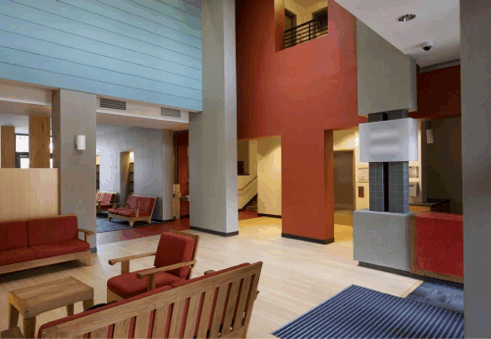
During preliminary design of this 4-story, 25,000 square foot building, First Community Housing was confronted with a requirement to replace and upgrade the existing public storm sewer to a 100-year flood capacity at a cost of approximately $300,000.
Analysis of Casa Feliz indicated the greenroof would actually cost less long-term than installing off-site stormwater-management improvements that would have been required otherwise by the City.

Seeking a more sustainable and less costly solution, the project team worked with Rana Creek Living Architecture to design an integrated system of living roofs and at-grade bioswales capable of retaining up to 80% of stormwater on site, such that only a new 10-year event pipe would be required for the storm sewer.
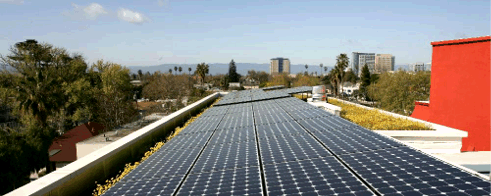
The two large top greenroofs have a custom designed built in place greenroof system, with one half containing the 16-kilowatt photovoltaic array.
The Tremco biodegradable modular greenroof system, BioTray™, was developed by Paul Kephart of Rana Creek and Kurt Horvath of Intrinsic Landscaping. The plants were propagated and transported to the site in coconut coir baskets. Once installed on the building’s lower-level roofs, these biotrays provided immediate erosion control and thermal resistance.
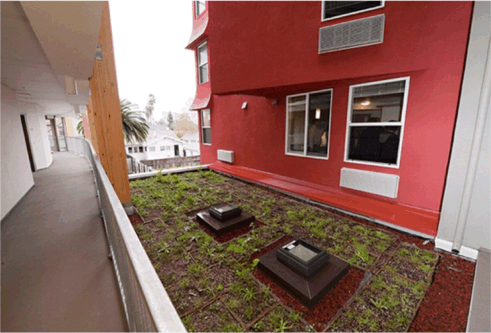
“The owner’s commitment to producing a sustainable building was recognized with a Gold LEED rating. In addition to natural lighting, another priority was the provision of natural ventilation and toxic-free building materials. Green building strategies include sustainable, recycled or regional materials, FSC certified furniture and site benches, water conservation, use of native and organic plants, low flow plumbing fixtures, energy efficient appliances, low-VOC emitting materials, and over 90% construction waste recycling.
The building’s crowning glory is San Jose’s first living roof.” ~ See the entire project profile at Rob Quigley Architects
The architects say that funding sources included the City of San Jose Housing Department, federal tax credits and State of California Multifamily Program funds.
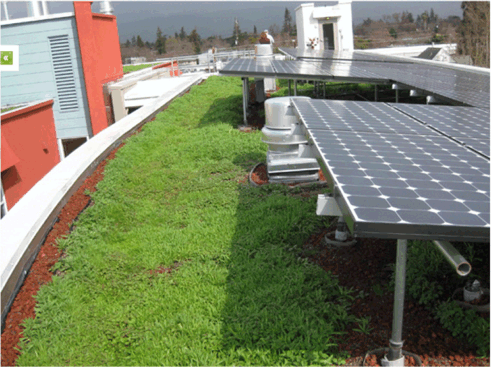
The Home Depot Foundation Case Study says:
“First Community Housing has achieved significant cost efficiencies by maintaining continuity in the design, construction, and overall development process. By integrating green design features from the start and relying on a tested process, very little money was spent on redesigns or contingencies. Long-term relationships with suppliers enabled the project to get discounts and favorable rates.
The more prominent (more expensive) green features were the photovoltaic system and the vegetated roof system. The PV system hard costs were covered by a Workforce Grant from the city of San Jose.
Any additional cost for the vegetated roof was offset by savings achieved in the storm drain system design. Without the vegetated roof, the storm drain system would have needed to be replaced, at a cost of roughly $300,000.
A key strategy for all First Community Housing projects is to conduct lifecycle financing. Up-front investments in energy-efficiency, water-efficiency, and durability are easily justified because they keep long-term management costs down – a critical element for a building projected to serve 55 years.”
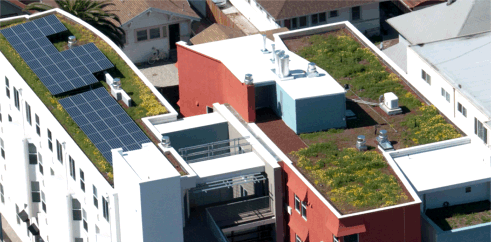
Learn more at Casa Feliz Apartments where you can see applicant criteria, download an application, or see the photo gallery.
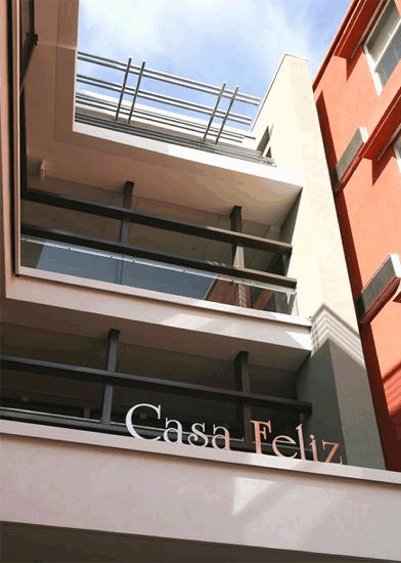
Did we miss something? We’d love to hear from you! Click here to see more information about this project in The International Greenroof & Greenwall Projects Database. See how you can submit yours here.
Love the Earth, Plant a Roof!
~ Linda V.
 Greenroofs.comConnecting the Planet + Living Architecture
Greenroofs.comConnecting the Planet + Living Architecture
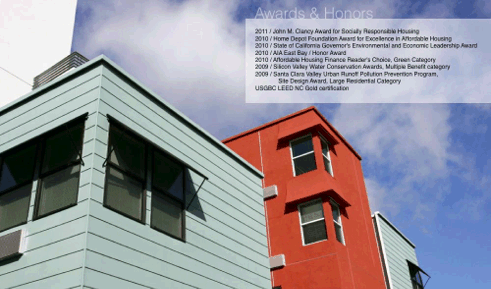


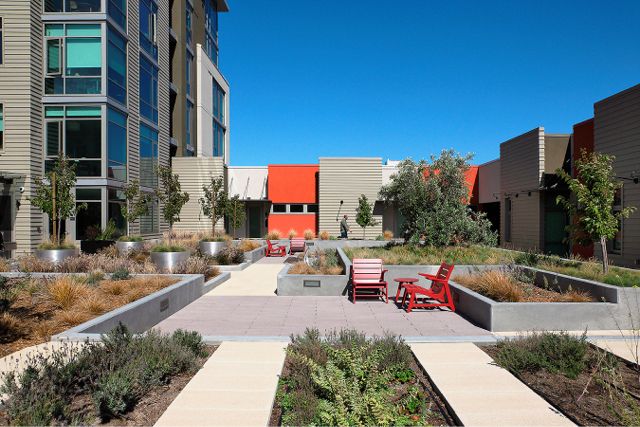




Bill The Md Roofer
The Casa Feliz project is simply genius! why isn’t this being done everywhere …
Payback periods are now not only “do-able”, but less than 10 years in many cases.
Great job!
John
Great INFO , thanks. Please write more on the subject =D